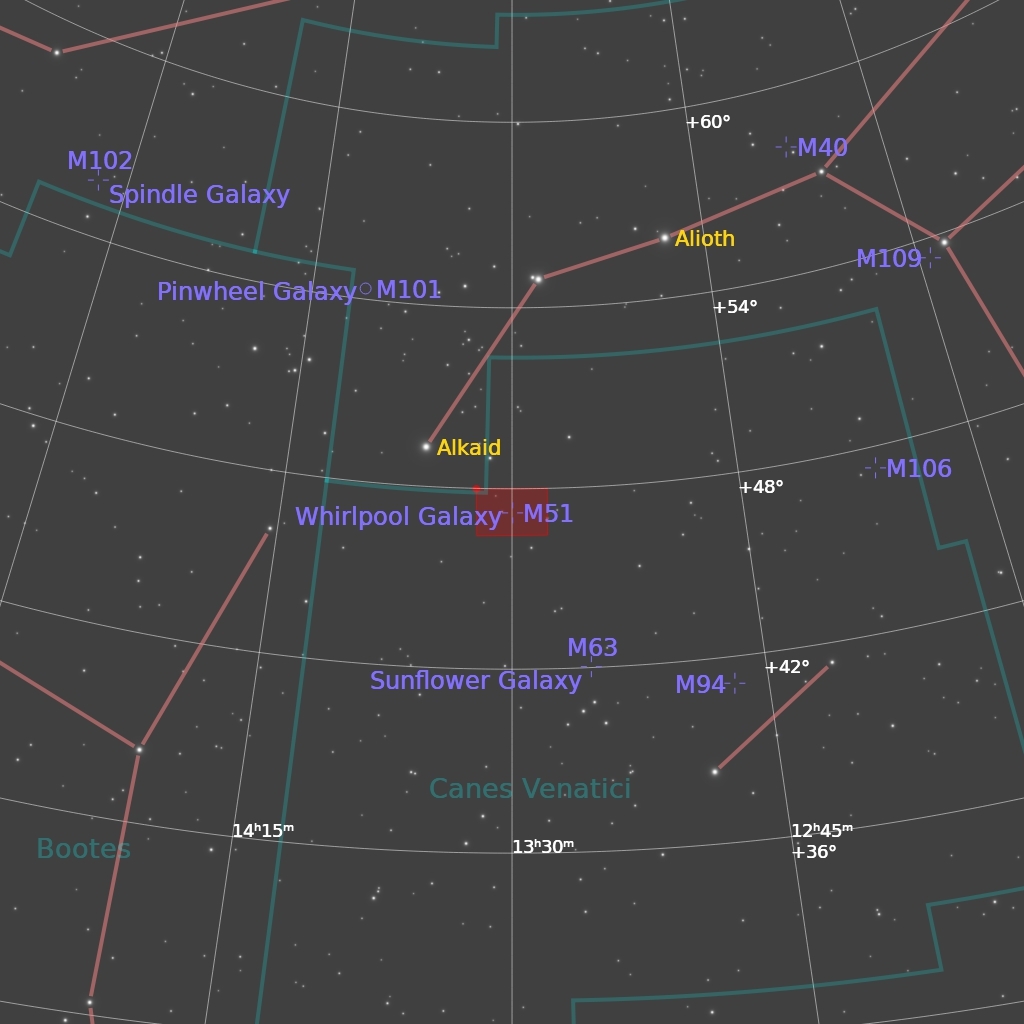Discovered 1773 by Charles Messier.
The famous Whirlpool galaxy Messier 51 (M51, NGC 5194) is one of the most conspicuous, and probably the most wellknown spiral galaxy in the sky.
M51 was one of Charles Messier's original discoveries: He discovered it on October 13, 1773, when observing a comet, and described it as a "very faint nebula, without stars" which is difficult to see. Its companion, M51B (NGC 5195), was discovered on March 21, 1781 by his friend Pierre Méchain, so that it is mentioned in Messier's 1781 catalog: `It is double, each has a bright center, which are separated 4'35". The two "atmospheres" touch each other, the one is even fainter than the other.' In addition to the description, in his personal copy of the catalog, Messier has added a small drawing, or sketch of the two "nebulae," M51 and NGC 5195, one of the rare cases a detailed drawing by Charles Messier of one of his objects is preserved. M51B (NGC 5195) was assigned an own catalog number by William Herschel: H I.186.
Occasionally, there is some confusion what is meant with the designation M51: The pair (justified by Messier's mention of both "nebulae") or the larger galaxy, NGC 5194. If the pair is meant, NGC 5194 is sometimes called "M51A", and independent of this, NGC 5195 is "M51B".
M51 is the dominating member of a small group of galaxies, which also contains M63 and a number of fainter galaxies. As it is about 27 million light years distant and so conspicuous, it is actually a big and luminous galaxy. The value of M51's (and the whole group's) distance is still not very well known. We adopt a value of 27 Mly here, in accordance e.g. with NED. Formerly we had used a value of 37 Mly, which is based on photometric methods and e.g. given by Kenneth Glyn Jones. Some authors give significantly lower values (less than 20 Mly), but a recent (2001) STScI Press Release gave 31 million light years.
This galaxy was the first one where the spiral structure was discovered, in spring 1845 by Lord Rosse, who made a very careful and acurate painting. Therefore, M51 is sometimes referenced as Rosse's Galaxy or Lord Rosse's "Question Mark" - he is cited with this name (see, e.g., NED).
According to our present understanding, the pronounced spiral structure is a result of M51's current encounter with its neighbor, M51B (NGC 5195, the fainter one in Messier's description). Due to this interaction, the gas in the galaxy was disturbed and compressed in some regions, resulting in the formation of new young stars. As is common in galactic encounters, spiral structure is preferably induced in the more massive galaxy. Halton Arp has included M51 as No. 85 in his Catalogue of Peculiar Galaxies as "Spiral with Large High-Surface-Brightness Companion".
For the amateur, M51 is easy and a showpiece if the sky is dark, but is quite sensitive for light pollution which easily makes it fade in the background. Under very good conditions, even suggestions of its spiral arms can be glanced with telescopes starting from 4-inch. Low magnification is best for viewing this pair.
The Hubble Space Telescope has investigated especially the central region of M51. Its compact nucleus is now classified as of Seyfert type 2.5. Newer HST investigations (published 2001) focus on investigation of the inner spiral arms and dust clouds, which are the birth sites of massive and luminous stars. ESA's ISO (Infrared Space Observatory) satellite has investigated the Whirlpool Galaxy in the infrared light.
Image Session Details
-Location: 50.23°N, 8.46°E
-Target: M51 (NGC 5194) – Whirlpool Galaxy
-Integration: 48 × 90s = 1h 12m
-Camera: Nikon D3500 (APS-C DSLR) – ISO 400
-Telescope: Askar 103 APO + 0.8× reducer (576 mm)
-Mount: Bresser Exos-2 + OnStep
-Control: ASIAIR Mini
-Guiding: SVBONY SV165 + ASI120MM Mini
-Sky Quality: Bortle 4, SQM ~20.8
-Moon Phase: Waxing Crescent (~24%)
-Filter: None (stock DSLR)
-Date: 31 May 2025
-Object Type: Spiral Galaxy (interacting pair with NGC 5195)
-Constellation: Canes Venatici
-Apparent Size: 11′ × 7′
-Distance: ~23 million light years
-8000
General Properties
-Type: Spiral galaxy, SA(s)bc pec.
-Coordinates: 13h29m52.7s, +47d11m43s (J2000).
-Apparent Magnitude: 8.4 (V).
-Angular Size: 11.2′ × 6.9′.
-Distance: 7.22 Mpc (23.5 Mly).
-Constellation: Canes Venatici.
-Discovery: Discovered by Charles Messier (1773); spiral structure resolved by William Parsons, 3rd Earl of Rosse (1845).
Scientific Databases
[ POSITION ]
-RA: 202.469575°
-Dec: +47.195258°
-Redshift: 0.001745
-Radial velocity: 523.0 km/s
[ PHOTOMETRY ]
-Catalog: V=8.36, B=9.26
-V: 8.36
-B: 9.26
-B–V: 0.90
-Hubble type (from color): S0
-IRAS 12 µm: 1.36 Jy
-IRAS 25 µm: 2.38 Jy
-IRAS 60 µm: 32.00 Jy
-IRAS 100 µm: 123.00 Jy
-1.4 GHz flux: 0.04 Jy
[ DISTANCE ]
-7935000.00 pc (25.88 Mly, NED-D median, nDistance)
[ ALIASES ]
-Question Mark Galaxy, Whirlpool, Whirlpool Galaxy, 2MASX J13295269+4711429, 2XMM J132952.5+471144, IRAS 13277+4727, IRAS F13277+4727, LEDA 47404, M 51, MCG+08-25-012, NGC 5194, UGC 8493
-NED
Observation Notes
-Visual Magnitude: 8.4
-Photographic Magnitude: 8.9
